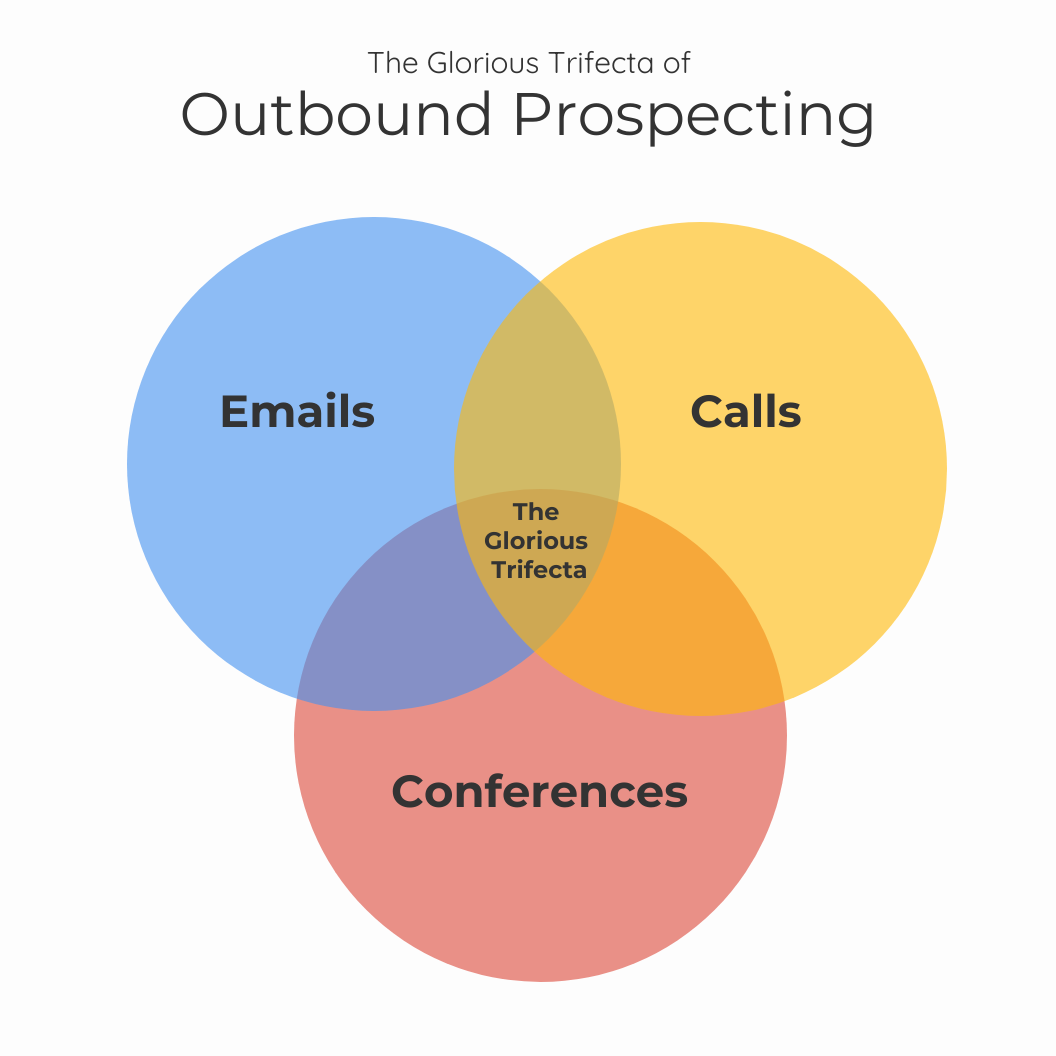You don’t have to hide it. You’re thinking “outbound? Cold calling?!” Yup, that’s right, we still do this and you’ll find out why below. But outbound prospecting, as we like to call it, because it’s fancy, doesn’t just mean hitting the phones. It also includes emailing and conferences, basically the trifecta of sales and business development to get our word out and get ourselves noticed by the most important part of our business: you! That’s right, as the customer you’re the most important part of our operation because even if we have the greatest thing on Earth, it doesn’t mean much if no one buys it.
So that’s what we do, we make folks aware that we have solutions to solve their microfilm scanning problems, problems you might not even know you have. And this article is a glimpse into our reasoning behind our efforts and how we think it benefits you as our (if we play our cards right) future customer. Because we really do think we can help a lot of organizations in ways they may not realize, and our goal is to bring that awareness to the table. Don’t get us wrong, we’re a business and we need to make money, too, but people only pay for things that are useful and we believe we have the right stuff.
So let’s charge right into it!
How You’ll Hear From Us
We use the Glorious Trifecta of Outbound Prospecting when it comes to getting in touch with folks: emailing, calling, and attending industry conferences.

Email isn’t dead, and it’s not going anywhere anytime soon. Although many of us cringe as we open our inboxes each morning, dreading the onslaught of junk mail, email is still the primary method of business communication. Sure, other ways of communication are becoming popular (like live chat, texting your primary contacts, phone chat apps), but email is still king.
According to TechJury, about 347 billion emails are sent each day in 2023. That’s incredible!!
So why are we still sending emails to try and get your attention about microfilm and microfiche scanning? Because we’re not expecting you to see one email, drop everything to call us, and commit to a digital conversion project on the spot. No, we’re keeping you informed through small and continuous touch points so that you know we’re out there, and when it’s time to take your dusty old microfilm reader-printer and chuck it in the garbage, you’ll remember who can scan your microfilm reels:
“BMI (long, thoughtful pause) … that’s right, they sent me those extremely useful and charmingly tactful emails about microfilm and microfiche conversion. I’ll call them!” This, my friends, is our goal.
Calls
Ol’ reliable! Calling has a bad rap these days, and for good reason: who wants to get a phone call right when you’re sitting down for dinner, and especially from someone at a call center? “No, I don’t need a new mattress!!”
We’re not trying to be mindless robots calling you and plowing through your deflections hoping to trick you into a deal. We legitimately want to chat with you about your microfilm records and how to take you from analog to digital to make your life, and everyone else who uses microfilm, better.
Trade Shows/Conferences
As the third leg of the outbound stool, industry conferences are great; our sales reps get to hit the road and meet clients and prospective clients face to face. Emails are good to generate awareness, and calls are great to make that human connection by chatting it up on the phone. But nothing compares to a face-to-face conversation, and conferences are one of the best methods to meet you and other people like you in a concentrated location.
Sometimes we put all three together, with the conference as the climax of the effort: we’ll send out an email to conference attendees and have our reps follow up with calls to make that back-to-back connection, seeing if you’re able to stop by our booth and have a quick chat about your digital conversion projects. The goal of the effort is to make that in-person meeting so we can show you we’re real people that can help you with your digital goals.
Why We’re Initiating Conversations With You (aka Interrupting You)
We’ll be honest and say that we’re interrupting. That’s the whole point! We all go about our daily routine and don’t think too much about issues that aren’t right in front of us. And even if they are right in front of us, we usually choose to ignore it. Same goes for microfilm scanning: it’s not something that’s an emergency and can usually be pushed off until later, if even thought about. And that’s why we’re interrupting you, to get you thinking about microfilm and the ways in which your work life could improve through digitization.
Here’s why we’re interrupting:
First, we want to ask if you even have any projects that we can help you with. Projects can include microfilm and microfiche scanning and conversion, digital to digital legacy data migrations, data hosting in our secure cloud, and software development and custom coding services. Our primary focus is microfilm and microfiche scanning, but there’s always a possibility we can help in other areas.
Second, we’re contacting you to pass along information and knowledge, not just pitch our services! If you’re interested in working with us then of course we’re ready to roll (pun intended), but we’re really not trying to pressure you into making any hasty moves. Many of the projects we work on didn’t happen overnight but instead were a long, slow process to get anything started. Data conversion projects need some decent planning and we don’t expect rapid action, which is exactly why we try to connect with you early so we can give you useful information and help along the way.

Reasons You Won’t Want To Talk To Us
You won’t hurt our feelings. Well, maybe if our business development folks call you and you outright reject them they may feel a bit down, but that’s show biz, baby!
Here are some thoughts that might pop into your head and why you wouldn’t want to speak with us:
- “This isn’t an emergency.” Like we mentioned above, the projects we work on don’t usually happen quickly so there’s always the voice in your head that says “this can wait. Don’t do today what you can put off until next year!”
- “We missed the budget cycle.” Funding and budget cycles are quite the fun game, right? It seems that if you don’t hit the timing just right, you’re out on a limb and are pretty much stuck until you can ask for money. But when you missed the boat, that’s the perfect time to start planning! There’s no rush, no scrambling to find the right partner, no pressure. Researching your microfilm conversion options when you don’t need to is the best time, just like grocery shopping after a meal. (you know, so you don’t toss a few packs of Oreos in the cart because they look tasty)
- “Microfilm scanning is too expensive.” Maybe, maybe not. This all depends on who you’ve spoken with in the past and what your requirements for the project are. First, think about when you last looked into a scanning project. If it was a couple of years ago, technology has changed a bunch since then and there are probably new ways of solving your problem that might make it more cost-effective. Second, if you didn’t speak with us then you probably got a quote for a “traditional” conversion project. These definitely can be expensive when compared to our alternate solution, Digital ReeL. If you want to see what the differences between a traditional and a Digital ReeL microfilm scanning project are, check them out here.
- “It’s more of a dull pain than a broken bone.” Even if you want to scan your microfilm, is it really worth the effort and money to do it right now? Sure, it’s a pain in the rear to have to use the rolls of film and sheets of microfiche, and our reader-printer is on its last legs, but everything’s still working! We can keep going, it’s just a nuisance for now.
- “What’s microfilm?” Very funny.
Reasons You Might Want To Talk To Us
If we’re lucky, you’ll already be in the process of researching digital conversion and we happened to catch you at the perfect time. We’re not holding our breath.
Even if you’re not necessarily thinking about microfilm scanning at this exact moment (or the moment you hear from us), it may behoove you to take a few minutes to talk over potential projects for the future. Why? Let’s touch on a few reasons below.
- Natural disasters are all too common, and we’re usually not as prepared as we think. Flood, tornadoes, earthquakes, and fires are well-known disasters, even if we’re not in a part of the country that experiences them on a regular basis. If one of these natural disasters happened where you keep your microfilm (or even digital data storage!), would your records survive?
- Theft probably isn’t what you’d think about when you hear microfilm, but it happens. Even in community hallmarks like libraries, microfilm of historic newspapers go missing and the content is lost forever.
- Deterioration and decay can cause irreparable damage to microfilm, especially if not caught early. If you’re not storing your microfilm and microfiche properly, you could be accelerating the process of degradation. If your film is handled on a regular basis, that can also cause wear and tear over time due to dust, dirt, oils from people’s hands grabbing the material, and just plain overuse.
- Bombs. Not kidding. One of our reps chatted with a court staff member that said a disgruntled employee came back to their office with a bomb strapped to him and blew himself up, taking their microfilm records with him.
Accidents happen, and by the time they’ve wrought their havoc it may be too late for your records.
Better to be prepared than sorry!
What’s In It For You?
We know what’s in it for us – digitizing your microfilm, our favorite! But more importantly, here’s what’s in it for you:
- No more hardware. You can finally toss your old reader-printer and never have to use that dinosaur again!
- No more physical copies of records. If you scan your records to digital and have a backup copy (or two), you may even be able to get rid of your physical copy.
- Faster retrievals. Digital information can be accessed with incredible speed, even across millions of records. Imagine the amount of time you’ll save by just typing in what you’re looking for and finding it almost instantly instead of having to go find a physical microfilm roll, load it onto a machine, then scroll around for awhile before finally getting what you need.
- Increased productivity, less wasted time. When you’re not spending time handling physical microfilm, you can work on activities that actually provide value to your organization.
Digital access for new employees that aren’t familiar with old media types. One of the options you have when you work with BMI is to use our Digital ReeL application; we create a digital replica of your microfilm to capture 100% of the data. An inherent benefit is that people familiar with microfilm and microfiche can instantly relate to the presentation of the digital images, but individuals that haven’t used microfilm see it as a sleek and intuitive internet platform. It’s a win-win!
Planting Seeds To Grow Oaks
With all the effort we put into outbound, it’s exciting when we connect with individuals who are excited to discuss microfilm scanning. It’s nerdy, yes, but we love microfilm and we could talk with you all day about it. The goal of our outbound efforts is definitely to find organizations that we see as good fits for the type of projects we provide, and we’re planting seeds along the way, continually adding a bit of water here and there to grow those seeds into oaks.
Every time you hear from us we want it to be an enjoyable experience, whether a phone call from one of our business development folks asking about your microfilm archives, an email with new blog posts that we think you’ll find helpful, or seeing a couple of our sales reps at a show and chatting it up with them to put faces to the BMI name.
Mostly, we want you to be aware of your options if you decide to move forward with a microfilm scanning project. There are many ways to move forward with digital scanning, and we can help you navigate the digital landscape, giving you our take on best solutions and also describing potential pitfalls if you don’t digitize or if you do it in a less than stellar way.
We’re records folks; we love this stuff!
Next Steps
Reach out to us today! Click the “Get Your Quote” button below, fill out the form, and we’ll quickly reply to you to discuss your project.
Further Reading
Take a look at these three articles that are also related to microfilm digitization:
“How Much Does Microfilm Scanning Cost?” describes the 9 factors that will affect the price you pay for microfilm scanning. If you’re starting to research microfilm digitization, this is a great place to start and get a ballpark budget idea.
“How To Choose The Right Microfilm Scanning Partner” is a guide to help you evaluate the various scanning companies you reach out to. Not all microfilm scanning is the same, and choosing the right company is a critical first step in making your project successful.
“The BMI Microfilm Scanning Process” is our 10-step process to take your microfilm from hard copy to digital. Every company has their own method, and we’re happy to show you ours!

